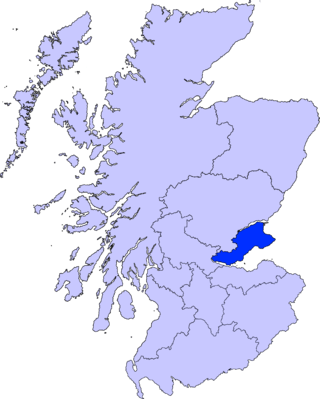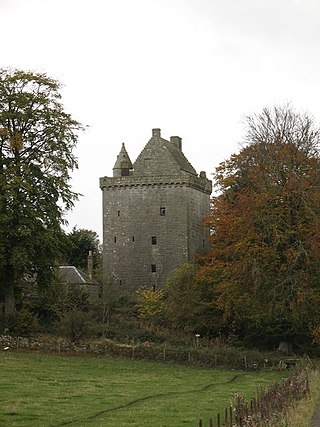Cupar is a town, former royal burgh and parish in Fife, Scotland. It lies between Dundee and Glenrothes. According to a 2011 population estimate, Cupar had a population around 9,000, making it the ninth-largest settlement in Fife, and the civil parish a population of 11,183. It is the historic county town of Fife, although the council now sits at Glenrothes.

North East Fife was one of three local government districts in the Fife region of Scotland from 1975 to 1996.

Ceres is a village in Fife, Scotland, located in a small glen approximately 2 miles (3 km) over the Ceres Moor from Cupar and 7 mi (11 km) from St Andrews. The former parish of that name included the settlements of Baldinnie, Chance Inn, Craigrothie, Pitscottie and Tarvit Mill.

North East Fife is a county constituency in Fife, Scotland, represented in the House of Commons of the UK Parliament by Wendy Chamberlain of the Liberal Democrats since the 2019 general election.

Springfield is a village that lies at the edge of the Howe of Fife, to the south-west of the town of Cupar, Fife, Scotland. The origin of the community is thought to be from the linen industry in the 19th century. The Church of Scotland parish church was built in 1861, and now shares a minister with nearby Ceres and Kemback. The church garden was originally intended to be a cemetery, but the high water table prevented this. The community is surrounded by fields; agriculture is still an important part of the economy of north east Fife.

Pitcairn House is a ruined 17th century laird's house, located in the modern Collydean residential area of Glenrothes, in Fife, Scotland. Pitcairn House was not, as is sometimes reported, built by the Picts, a people whose culture disappeared from Scotland around the 10th century. The name Pitcairn does, however, have roots in the Pictish language, combining the common prefix pit, meaning a portion of land or farm, with the Gaelic cairn.

Lordscairnie Castle is a ruin situated near Moonzie, 2.5 miles (4.0 km) north-east of Cupar, in Fife, Scotland. It is protected as a scheduled monument.

Letham is a small village in Fife, Scotland, located just off the A92, around 5 miles from Cupar. According to the 2001 Census, Letham has 138 residents, although this has without a doubt increased in the previous years.

NHS Fife is an NHS board which provides healthcare services in Fife, Scotland. It is one of the fourteen regions of NHS Scotland.

Scotstarvit Tower is a tower house in Fife, Scotland. It is situated 2 miles (3.2 km) south of Cupar, between Tarvit Hill and Walton Hill, south of the River Eden, and west of the A916 road.

The Howe of Fife is the broad, low-lying valley of the River Eden, lying between the Ochil Hills and the Lomond Hills in Fife, Scotland. Howe, in Scots means a hollow or a plain bounded by hills. The alternative terms Laich of Fife and the Valley of Eden have fallen from use, as has Stratheden, save for the hospital near Cupar.
Cupar Castle was a royal castle at Cupar, Fife, Scotland. It was located on a small hill or motte that is known as Castle Hill next to Castlehill Primary School in Cupar. No vestiges of the castle remain above ground.

Scotland's Rural College (SRUC) is a public land based research institution focused on agriculture and life sciences. Its history stretches back to 1899 with the establishment of the West of Scotland Agricultural College and its current organisation came into being through a merger of smaller institutions.
Logie is a parish and village in east Fife, Scotland, 5 miles north-east of Cupar.

Adamson Hospital is a small community hospital in Cupar, Fife which was established in 1904. It was expanded in the 1930s and again in the 1970s when a health centre and two GP practices were added. A redevelopment project began in 2009 which further expanded the hospital and was finished in 2012. It is managed by NHS Fife.

Stratheden Hospital is currently a small community hospital in Stratheden, Cupar, Fife which was originally called Fife and Kinross District Asylum. Its name was changed to Stratheden Hospital in 1948. It was a centre of excellence in Child and Family Psychiatry from the 1960s. In the 21st century, it caters for psychiatric health. It is managed by NHS Fife.
(Johnston) Douglas Haldane MBE, FRCPsych was a pioneering Scottish child psychiatrist, who established Great Britain's first department of Child and Family Psychiatry in 1960 in Cupar in Fife. He opened the first family in-patient treatment unit in Scotland and introduced a range of innovative therapeutic art interventions. He sat on numerous policy working parties and led a variety of professional committees. He became a founding member of the Association for Family Therapy. He was a co-founder of the Scottish Institute of Human Relations. During his time as an academic, he devoted much time to influence the development of a government policy on Marriage. In the 1960s, he was also an elder of the Church of Scotland and a member of an early Iona Community group.
Dr John Fraser FRSE FRCPE (1844–1925) was a Scottish physician. He was Commissioner in Lunacy for Scotland from 1895 to 1910.














